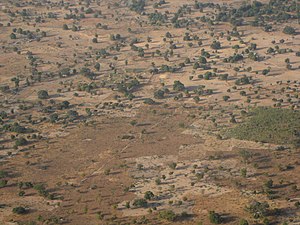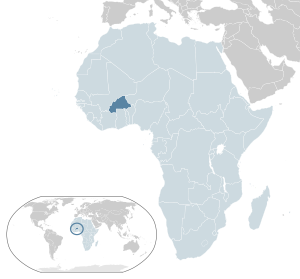

Burkina Faso is largely wild bush country with a mixture of grass and small trees in varying proportions. The savanna region is mainly grassland in the rainy season and semi desert during the harmattan period (defined as the period when stormy and dusty Sahara winds blow dry and hot). Fauna, one of the most diverse in West Africa, includes the elephant, hippopotamus, buffalo, monkey, lions, crocodile, giraffe, various types of antelope, and a vast variety of bird and insect life.[1] The country has 147 mammal species, 330 aquatic species including 121 species of fish and 2067 different plant species.[2] Of the plant species, the dominant endemic species are shea tree (Butyrospermum parkii) and the baobab, the former plant species has immense economic value to the country.[1][3]
To ensure conservation and preservation of the wildlife of Burkina Faso, four national parks have been established. These are the Po National Park in the south-centre of the country, Arli National Park established in 1954 in the southeast, W of the Niger National Park, a trans frontier park existing since 1957 in the east bordering Benin and Niger and the Deux Balés National Park. The forests, fauna and fish have been declared part of the national estate of Burkina Faso.[1][4] In addition, the List of national parks of Burkina Faso consist of one UNESCO Biosphere reserve, three complete reserves, six partial reserves and ten protected forests. However, according to conservation classification conducted between 1936 and 1957, the country has 78 protected areas that cover 38,369 km2 (14,814 sq mi), which accounts to about 14% of the area of the country.[5]
- ^ a b c "Burkina Faso:Plants and animal life". Encyclopædia Britannica. Retrieved 24 April 2011.
- ^ Adjima Thiombiano, Marco Schmidt, Stefan Dressler, Amadé Ouédraogo, Karen Hahn, Georg Zizka. 2012. Catalogue des plantes vasculaires du Burkina Faso. Boissiera 65, Conservatoire et Jardin Botaniques de la ville de Genève. 391 S. ISBN 978-2-8277-0081-3
- ^ "Wild Shea Tree Benifitting [sic] Burkina Faso: Women Engaged in Shea Sector Gain From Trade In 'Shea Butter'". Gender and Trade: Commonwealth Secretariat. Archived from the original on 5 June 2011. Retrieved 24 April 2011.
- ^ Cirelli, Maria Teresa; Food and Agriculture Organization of the United Nations. Development Law Service (2002). Legal trends in wildlife management. Food & Agriculture Org. p. 40. ISBN 978-92-5-104785-9. Retrieved 24 April 2011.
- ^ "Burkina Faso" (PDF). BirdLife International. pp. 117–123. Archived from the original (PDF) on 15 October 2012.